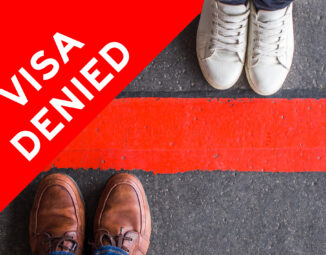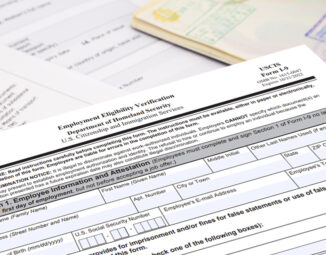H-1B Cap Season is Approaching: Are you Prepared?
April 1, 2016 is the filing date for all H-1B visa petitions that are subject to the “Cap.” Many HR staff – especially if they are new in the role – are unfamiliar with the fundamentals of the H-1B visa. This article provides some basic facts that should help our readers familiarize themselves with the most common skilled worker visa available to nonimmigrant foreign nationals.
The H-1B visa is available for nonimmigrants with an offer of employment in a “specialty occupation,” an occupation for which a bachelor’s or higher degree or its equivalent is normally the minimum entry requirement. The foreign national must have completed a U.S. bachelor’s or higher degree required by the specific specialty occupation from an accredited college or university or hold a foreign degree that is the equivalent to a U.S. bachelor’s or higher degree in the specialty occupation.
H-1B visas are issued in increments of up to three years, and a person may hold H-1B status for a maximum of six years. Extensions beyond the six year limit are available in certain circumstances if the foreign national is in the process of applying for employment based permanent residence.
Congress has determined that the H-1B visa have an annual numerical limit, or “cap,” of 65,000 new visas each fiscal year, which begins on October 1. Twenty-thousand petitions filed on behalf of beneficiaries with a U.S. master’s degree or higher are exempt from the cap. Additionally, H-1B workers who are sponsored by, or employed at, an institution of higher education or its affiliated or related nonprofit entities or a nonprofit research organization, or a government research organization are not subject to this numerical cap. Up to 6,800 visas are set aside from the 65,000 each fiscal year for specialty workers from Chile and Singapore under the terms of the free trade agreements the U.S. has signed with those countries.
By April 5, 2015 United States Citizenship and Immigration Services (USCIS) received a record breaking 233,000 H-1B visa applications for Fiscal Year 2016. When the number of applications exceeds the number of visas available USCIS conducts a computer-generated random selection process to select which H-1B petitions for the upcoming fiscal year would continue to full adjudication. If approved these H-1B petitions will be eligible to receive an H-1B visa number and begin working on October 1 of that fiscal year. USCIS conducts two random selections, first on petitions qualifying for the 20,000 “master’s or higher degree” (advanced degree) exemption, and second on the remaining advance degree petitions together with the general H-1B pool of petitions, for the 65,000 cap.
What do employers and/or foreign nationals need to do to be prepared?
1. Identify those foreign workers whom you will be sponsoring for H-1B status. Ordinarily new H-1B applicants are foreign nationals in some other status in the U.S., usually F-1 students.
2. Remember the benefit of OPT: The optional practical training program, or OPT, allows nonimmigrant international students and new graduates to extend their time in the U.S. on their F-1 student visa status to gain on-the-job-learning for up to a year. F-1 STEM (Science, Technology, Engineering, and Mathematics) graduates who are working pursuant to a grant of Optional Practical Training are eligible to extend their OPT for an additional 17 months. Proposed changes – if approved – will extend this period to 24 months. This means that foreign students who are STEM graduates will have multiple chances to apply for an H-1B visa if an initial attempt is unsuccessful due to the lottery. To benefit from the STEM extension, the employers must be registered with E-Verify, a system that enables employers to verify the employment authorization of a potential worker at the time of hire.
3. Consider alternatives: Besides the H-1B, there are other options to consider if you have a foreign worker you just don’t want to lose:
a. O-1 Visa: The O-1 visa is suited for individuals of extraordinary ability or achievement. The O classification is a useful and flexible alternative to the H-1B program because there is no cap and no time limitations. O-1 beneficiaries in the sciences, arts, education, business, or athletics must have extraordinary ability “demonstrated by sustained national or international acclaim.”
b. L-1 Visa: The L-1 visa is an option for international organizations with offices in the United States who transfer employees to the United States for temporary periods of time as executives/managers or persons with “specialized knowledge.” Eligibility depends on a number of factors and it is important to remember that time spent in L-1 status will count against the six year limit available in H-1B status.
c. EB-1. In certain rare cases you may have a worker who is of such extraordinary ability that he or she is eligible for employment based permanent residence as an alien of extraordinary ability. Like the O-1, but subject to more rigorous scrutiny, the EB-1 option is uncommon, but a worthwhile consideration.
d. TN: The TN visa is available to citizens of Mexico and Canada based on the North American Free Trade Agreement (NAFTA). The TN nonimmigrant classification permits qualified Canadian and Mexican citizens to seek temporary entry into the United States to engage in business activities at a professional level in certain professions set forth in the treaty.
4. Don’t Delay: The date for filing H-1B Cap subject petitions is April 1. That’s just over eleven weeks away. Start now identifying the individuals you will be sponsoring for H-1B classification and considering alternatives where necessary.
5. As always, consult with an experienced immigration attorney who can explore alternatives and help guide you through the complex maze that constitutes U.S. immigration law.



